How to Repair Ceiling Holes
by: Dale Cox
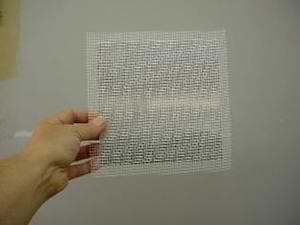
Ceiling holes present a particular challenge when attempting to do repairs. Because gravity will pull down on the patching material as it dries, a bulge can develop in the surface and cause an unsightly finish when you're done. If you have a large ceiling hole of more than 6 or 7 inches to repair, you should use the process at this link to do it.
If you're dealing with a smaller ceiling hole, you can use a self-sticking, aluminum reinforced patch like the one shown here for a quick, easy repair process. A drywall patch like this can be found just about anywhere wall repair materials are available. These are basically fiberglass-mesh over a thin piece of perforated aluminum. They come in a few sizes starting at about 4 inches and going up to 8 or 10 inches. These are self-sticking so you just have to apply it over the hole, sticking it to the surrounding surface and then cover the whole area with a few coats of joint compound.
What You'll Need
#1 - Apply an Aluminum Wall Patch

Measure the hole to be covered and get a patch that measures a couple inches more than that. An inch overlap on each side of the opening should be enough to make the patch work as intended. Be sure the ceiling surface around the hole is smooth and free of dust or other contaminants before applying the patch. If you have water damage or other stains, seal that first with a primer-sealer and let it dry before applying the patch.
#2 - Apply a First Coat of Mud
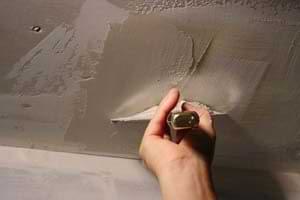

Using setting compound, also called mud, for this job will make for the best possible result but ready-mixed compound will work too and it won't require mixing. It will, however, take longer to do the job because the ready-mixed compound will take longer to dry.
Start by applying a thick coat of either type mud over the whole patch, overlapping onto the surrounding ceiling by a few inches on all sides. Immediately go back over the mud with the joint knife to skim off the excess, leaving a very thin layer over the patch and the surrounding ceiling.
This first coat is just intended to fill in the mesh and start to blend the surface into the ceiling material so don't expect it to hide the patch. Ignore any ridges in the surface left by the knife blade or other roughness in the mud as you skim, these will be removed later. Let the mud dry completely.
#3 - Apply A Second Coat of Mud
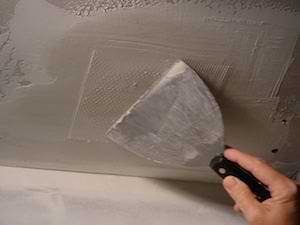
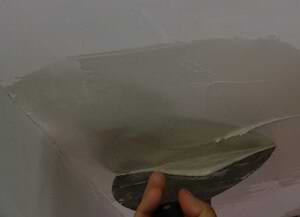
When the first coat has set and dried, use the joint knife in a forward stroke to shave off any ridges or bumps in the surface of the mud. Lightly sand the edges around the perimeter to blend it with the existing ceiling paint. Gently wipe off the sanding dust with a damp cloth before proceeding.
Apply another coat of mud over the whole patch, overlapping the edges of the first mud coat and spreading out onto the surrounding ceiling. As with the first coat, apply excess mud first and then skim it off to leave a smooth finish.
Stroke with the joint knife perpendicular to the direction you used with the first coat. If you stroked east to west with the first coat, stroke north to south with this one. This will help to achieve an overall level finish in the repair surface and to hide the edges of the aluminum. Let the mud dry completely and shave/sand as necessary to remove any roughness in the surface before wiping the dust away.
#4 - Apply a Final Coat

Apply a third and final coat of mud to cover the whole patch, again, overlapping the previous mud coat and spreading out onto the surrounding ceiling. Use the same process of thick coat followed by skimming. Again, skim with perpendicular strokes to the previous coat.
Alternating your strokes should have tapered the aluminum edges into the existing surface making them invisible at this point. If that didn't happen and you can still see the metal showing through the mud, you will need to apply another coat to cover it. Apply a bit of fresh mud over the visible metal and stroke parallel over the edge to blend it with the rest of the repair surface.
#5 - Sand and Touch Up the Paint
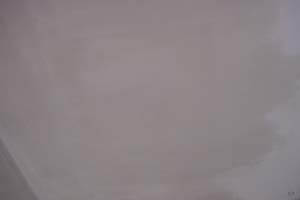
Let the final coat of mud dry completely before attempting to sand it and touch up the paint. Use a light touch to sand the whole area giving extra attention to the edges to blend them with the existing ceiling paint.
To finish, brush away the sanding dust and lightly wipe off the residue with a damp rag before touching up the paint. If your finish paint is flat latex, it will be self-priming. If you're using semi-gloss, oil-based, or another shiny paint finish, prime the patch with a latex primer or other flat latex paint first.
 Repair Large Holes in Walls and Ceilings
Repair Large Holes in Walls and Ceilings